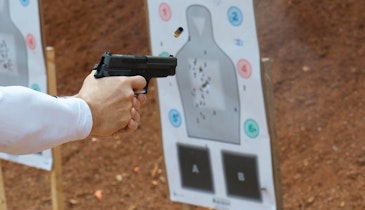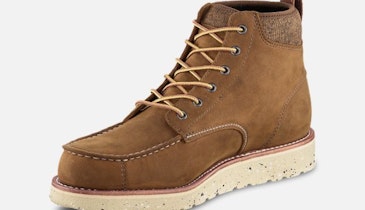
One of the most common myths in shooting is bullet weight alone resists wind drift. Flat trajectory and minimal wind deflection at longer ranges is all about bullet ballistic coefficient, not raw speed (although speed also helps). (Photo: Patrick Meitin)
Many factors dictate success in long-range shooting, including range and bullet velocity in relation to elevation adjustments, wind velocity and bearing as it affects windage corrections, as well as the effect of various atmospheric elements.
A bullet’s ballistic coefficient (BC) is influenced by every one of those variables. BC is a function of sectional density, a bullet’s diameter in relation to its length, and provides an indication of how well a projectile slips through the atmosphere — like comparing a boxy pickup truck (a low-BC round nose projectile) to a Corvette (a pointed, high-BC projectile) with identical horsepower (or in this case, muzzle velocity).
When I began varmint shooting as a teen targeting eastern New Mexico’s superfluous black-tailed prairie dogs, the subject of BC was seldom discussed among shooters. We loaded something fast and explosive and had at it. More recently, BC has become a hot topic with serious shooters, especially those bitten by the long-range bug.
Although interest in BC has soared, many outdated myths and misconceptions remain intact. If you can spell it out for your customers, you’ll help get them into rigs that meet their needs, keep them shooting, and keep them coming back into your store.
Myth 1: Bullet Mass Alone Resists Wind Drift
The most common BC misconception is that bullet mass alone resists wind deflection. I hear that even from shooters who should know better. Fact is, wind pushes on all bullets at an equal rate; be that a 20-grain .17-caliber or 220-grain .308. Wind deflection margins are directly tied to time of flight and not mass. The less time bullets spend in the air, the less opportunity wind has to deflect them off the mark.
BC relates how efficiently bullets slip through atmosphere, how quickly they shed velocity and more pointedly, how well bullets retain velocity and energy as they travel downrange. A bullet with a poor BC (marked by a stubby nature) sheds velocity much faster than one with a higher BC value (normally distinguished by a long, “spear-like” tip and boattail), no matter weight.
To better illustrate what that looks like on paper, let’s run a couple examples through a ballistics calculator including two projectiles with dead-even 3,100 fps muzzle velocities and 200-yard scope zeros. Our examples include an 87-grain Hornady V-Max shot from a .243 Winchester and a 110-grain V-Max shot from a .308 Winchester. Compare downrange results by plugging in BC (.400 for the .243, .290 for the .308 bullet), velocity (3,100 fps) and identical atmospheric conditions (sea level, 29.50 barometric pressure, 70 degrees, 50 percent humidity and 10 mph crosswind).
Given those elements, the .243 bullet deflects 6.4 inches (maintaining 2,425 fps velocity) to the .308’s 7.2 inches (now traveling 2,194 fps) at 300 yards. At 400 yards that spread widens to 18.7 and 21.7 inches, respectively, due entirely to the 6mm pill’s superior BC and retained velocity — the .243 still traveling at 2,222 fps to the .308’s 1,932 fps at that range. At 500 yards, .308 wind deflection nearly doubles, while the 6mm is affected by a margin of about 30 percent.
This clearly illustrates how poor BC becomes more pronounced as ranges stretch, typically beyond 350 yards. In truth, most game is shot at much closer range. At these “standard” ranges you really need not worry about substantial bullet drop and/or wind deflection, so BC has less bearing.
Myth 2: Light Bullets Always Shoot Flatter Than Heavy
Hand-in-hand with Myth 1, there are those who believe lighter bullets always produce flatter trajectories and will shoot, for example, 40-grain bullets from a .223 Remington instead of 55-grain. This belief hinges largely on the seduction of higher muzzle velocities. If 3,100 fps (average 55-grain/.223 Rem. velocity) is good, 3,700 fps (average 40-grain/.223 Rem. velocity) is better.
Returning to the realities of BC we find that lighter bullets launched at higher speeds also shed velocity faster due to lower BCs, actually arriving on target at lower velocities than their heavier mates. That might appear counter intuitive but running numbers through a ballistic calculator will bear this out.
Understand this is entirely range dependent. Out to, again, 300 to 350 yards, you’ll notice little difference. The lighter bullet is more likely to splatter dramatically, anchoring targets decisively. As an example, I normally load my .223 Remington with 40-grain poly-tipped bullets, but I also rarely use it to shoot past 300 yards as I own other rifles for such situations, especially when wind begins to stir. Heavier, long-for-caliber bullets provide their fullest benefits when long-range shooting in the wind.
Myth 3: When Ranges Stretch/Wind Blows, Burning More Powder Is the Solution
It is common to address longer shots or windy conditions by burning more powder, i.e. choosing a larger cartridge. This is basically sound, but only if heeding the precepts of BC. A poor BC bullet is a poor BC bullet. You might send it on its way at a higher velocity, but the parachuting effect of low BC is quickly equalized by bullets with superior BC.
Again, we are discussing long-range shooting combined with wind. Barn-burner varmint rounds buck gravity and wind deflection to a point, but eventually higher-BC bullets, even when launched at lower muzzle velocities, overtake those with poor BCs.
An easy example is found by comparing the hotrod .204 Ruger and venerable .22-250 Remington, both shooting 40-grain bullets. Many .204 owners shun 40-grain pills because muzzle velocities closely match a .223 Rem. The allure of the 4,000 fps benchmark gained with 32-grain bullets is understandable.
Yet comparing the .204 Ruger to the .22-250 Remington with same-weight 40-grain bullets, you’ll find the .20-cal bullet includes a BC of .275-ish, while the .22-cal version is .200-ish (based on Hornady V-Max and Nosler’s Ballistic Tip). Four-hundred-yard drop (with 200-yard zero) and 10 mph wind deflection are 14/15.2 inches verses 15.5/21.4 inches, respectively. The .204 pill launched at 3,800 fps, the .22-250 at 4,000. In this case, the smaller cartridge actually provides a slightly better showing. So why burn all that extra powder and deal with all the added bluster to achieve similar results?
Another important consideration is rifling twist in relation to bullet length/BC. My customized Savage 10 .223 Remington, for instance, includes 1:12-inch rifling twist, which stabilizes bullets weighing no more than, say, 55 grains. Heavier, long-for-caliber bullets, such as Sierra’s firebrand MatchKing, keyhole when shot from that rifle. Conversely, my Remington 700 VTR (with distinctive triangular barrel) includes 1:9-inch barrel twist, and shoots heavy bullets just fine, making it a superior long-range option in that round. There are computer programs to help determine required rifling twists, though most manufacturers provide recommendations in catalogs or on bullet packaging.
Myth 4: High BC Bullets Are Always More Accurate
Bullets with superior ballistic coefficients better retain velocity and energy at longer ranges, but that shouldn’t be confused with accuracy potential. Efficiency and precision are two different animals. Truth is, low-BC flat-base open-tip bullets can be just as accurate, if not more so, at moderate ranges than same-weight boattail designs.
I’ve heard arguments regarding gas seal in relation to base design, but the fact remains any well-made, balanced bullet is capable of impressive accuracy from the right rifle. I own a .30-06 Springfield, for instance, that shoots round-nosed bullets (with low BCs) into tighter clusters than same-weight pointed pills at 100 to 200 yards.
This is, again, range dependent. The longer the range, the more a high BC bullet benefits accuracy — especially at extreme ranges. When yardage becomes extreme, light varmint bullets with low BCs can actually shed so much velocity that they fall below supersonic speeds. When a bullet falls to transonic velocities, it typically destabilizes considerably. In general, stability is provided by speed, and as ranges grow longer, higher-BC bullets retain more velocity and generally provide greater impact consistency.
Myth 5: Ballistic Coefficient Is A Concrete Value
It’s easy to note the advertised BC of a particular bullet and assume it relates to every load, rifle and condition. Yet actual BC is multifaceted, if a real value can truly be established at all. Technically speaking, BC changes along every inch of a bullet’s path, as velocity hemorrhaging begins the moment a bullet leaves the muzzle.
Each new shooting session is also a new day, so to speak, so, advertised BCs are averaged over, say, a 200-yard span, shot at average speeds for cartridges most popular in a given caliber and with an established atmospheric ideal. You can rest assured manufacturers choose best-case scenarios to boost BC numbers. Sierra, at least, provides various BCs for single bullets based on various velocity parameters.
Highly variable atmospheric conditions are the trickiest part of the BC equation. The industry standard is established at sea level, 59 degrees and average barometric pressure. Bullet impact can vary a little or a lot, depending on how severe those atmospheric conditions change — the thin air of high-altitude improving BC considerably, for instance. Colder temperatures create denser air and cause bullets to impact lower. Warmer temperatures have the opposite effect.
Bullets impact lower on dry days, higher in high humidity. Dry air is heavier than “wet” air, as the oxygen in water is lighter than atmospheric nitrogen. All of those factors directly affect BC numbers. When building correction charts with the aid of ballistic calculators or smart-phone apps, it’s important to input information closely mirroring those normally faced in the field during periods you regularly shoot. For instance, my April Columbia ground squirrel cheat sheets vary from June prairie dog ones. The former are cool, moist, high-altitude Idaho affairs, while the later include hot, dry, lowland Wyoming deserts.
Understand, too, that at average ranges — 100 to 300 yards — these differences become a matter of splitting hairs. They’re only truly important only as ranges become extreme, say, beyond 400 yards.
In general, BC only factors in longer-range shooting or when wind begins to bend the grass or cause trees to sway. It also weighs more heavily when an inch or two here and there actually makes a difference to success. But better understanding of how ballistic coefficient affects bullet flight also assures you don’t make obvious mistakes and match the best projectiles to the task at hand.





